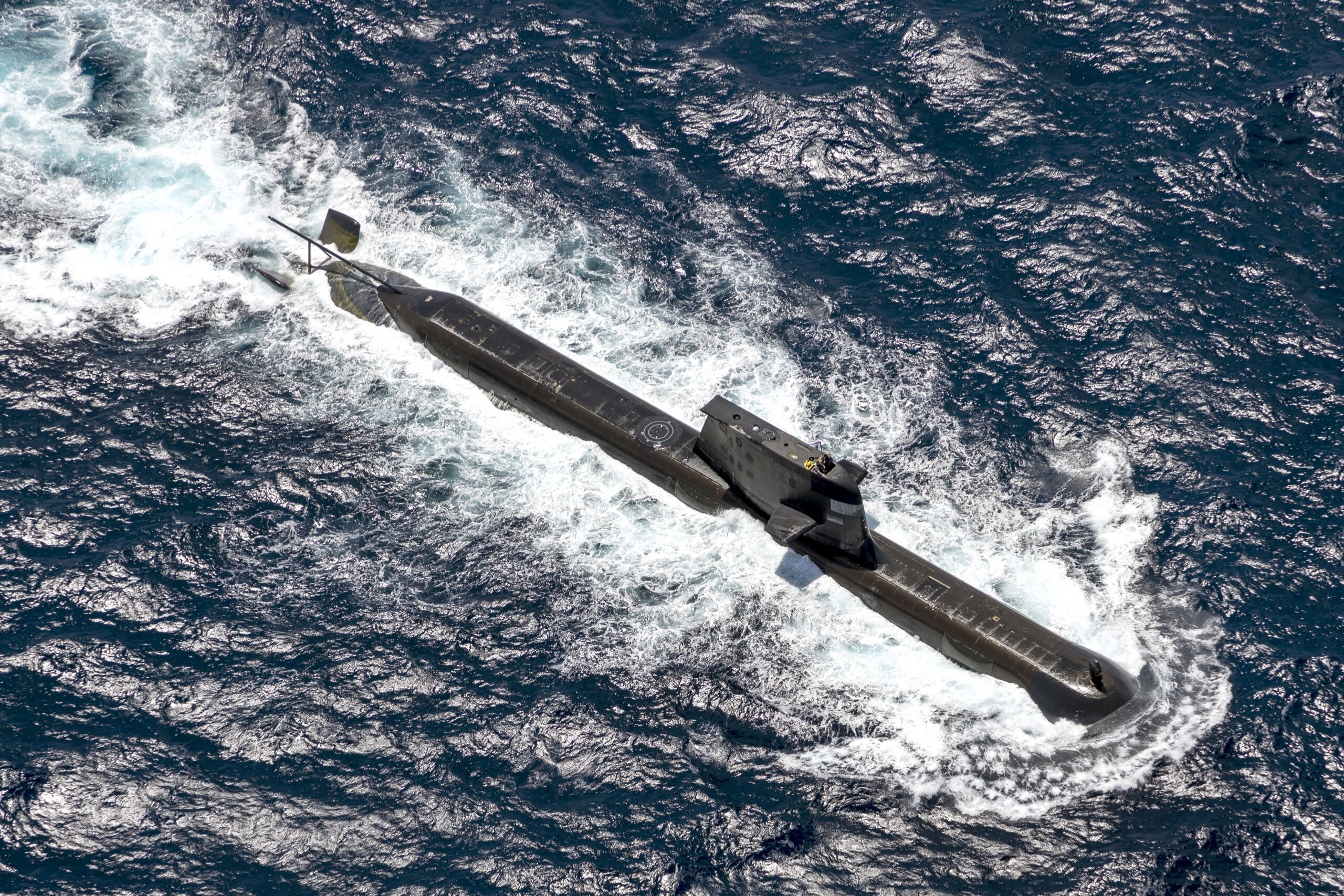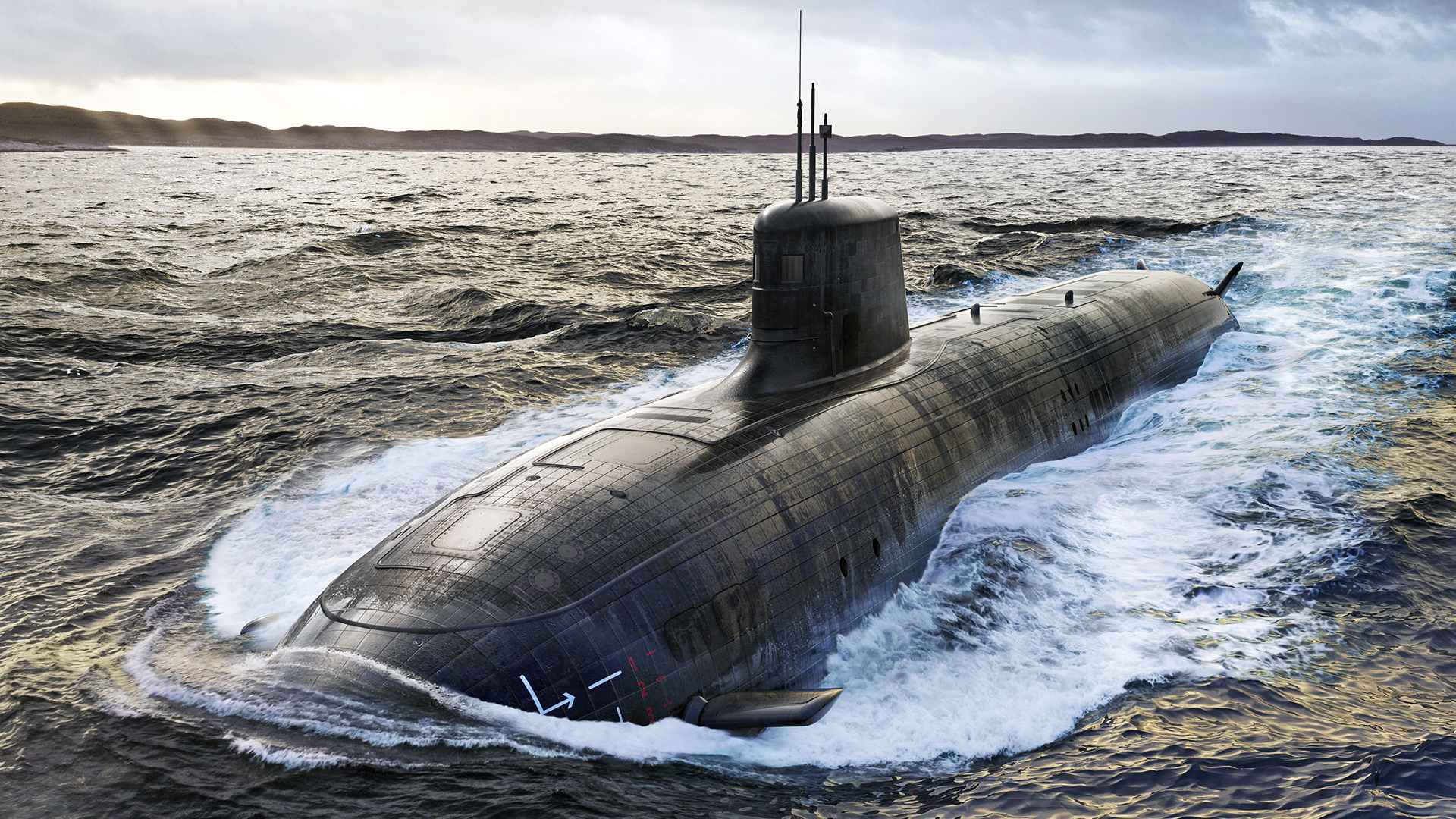We are learning more about the ambitious effort to build a new line of nuclear-powered, conventionally armed submarines for the U.K. and Australia that is a key part of the three-phased plan officially unveiled yesterday in San Diego.
The Australian Defense Ministry (MoD) provided some additional details in a document it released about how those boats – which at the moment are set to be delivered to the Royal Australian Navy in the early 2040s – will be built. The first of what is being called the SSN-AUKUS line of subs will be delivered to the Royal Navy earlier, by the late 2030s, because the U.K. already has nuclear-powered submarine construction infrastructure. That will follow the sale of at least three, and up to five, Virginia-class nuclear-powered, conventionally armed submarines to Australia by the early 2030s.


Those boats will be based on the U.K.’s next-generation nuclear attack submarine designed to replace the Astute class, and augmented by U.S. technology.
Vice Admiral Jonathan Mead, the head of Australia’s AUKUS task force, told Australia’s ABC.net news outlet that his nation was up to the task of building its own nuclear-powered boats and the design work was well advanced.
“SSN-AUKUS is actually quite mature in the design, it’s about 70% mature,” he said. “The US will incorporate key weapons and combat systems into that submarine. The UK are very much looking forward to that.”
Australia’s nuclear-powered submarine program will cost up to $245 billion over the next three decades, an Australian defense official said on Tuesday, according to Reuters. And that does not include purchasing at least three and as many as five Virginia-class submarines from the U.S., which will include an as-yet-determined mix of new and used boats, Mara Karlin, Performing the Duties of Deputy Under Secretary of Defense for Policy, told reporters, including The War Zone, on Tuesday.
The SSN-AUKUS submarines will have “a high degree of commonality with” the U.S.-made Virginia class SSNs, according to the Australian MoD. “This commonality in design, components and performance will help with the transition to SSN-AUKUS while enhancing interoperability among the AUKUS partners.”
Specifically, the SSN-AUKUS class subs “will incorporate US technology such as propulsion plant systems and components, a common vertical launch system (VLS) and weapons,” according to the Australian MoD.
But there are some differences. While the older, aging Los Angeles-class fast attack submarines and earlier model Virginia-class fast attack subs have 12 VLS, later Virginia-class Block III models did away with those in favor of two large diameter 87-inch Virginia payload tubes (VPT) capable of storing and launching six Tomahawk land attack missiles used in strike operations. Block V versions add four large-diameter multi-purpose vertical launch tubes in an additional hull section known as the Virginia Payload Module (VPM).

Neither the Virginia-class submarines the U.S. will sell to Australia starting in the early 2030s, nor the SSN-AUKUS submarines will have the Virginia Payload Modules, according to the Pentagon.
“We defer to Australia for their list of specifications, but this was not one of them,” a U.S. defense official told The War Zone Tuesday.
And while the new line of submarines will incorporate U.S. propulsion technology, the reactors, for the U.K. and Australian SSN-AUKUS subs will be provided by Rolls Royce Submarine LTD., the company announced.
“We are delighted to be asked to play our part in delivering this element of the AUKUS Agreement and are well prepared to support through our nuclear expertise and engineering excellence,” said company President Steve Carlier in a statement. “For over 60 years we have provided the power to the Royal Navy’s nuclear submarines and we are proud to be playing a critical role in helping Australia acquire their own nuclear propulsion submarine capability.”
“Rolls-Royce will be providing the reactors to both UK and Australian SSN-AUKUS submarines,” Rich Whelband, head of Marketing & Communications, Submarines for Rolls Royce told The War Zone Tuesday. “In terms of timelines, it’s still early days but we are expecting to start manufacturing for SSN-AUKUS this decade (ie during the 2020s) and be ready to start delivering our first reactor components into the program in the mid-2030s. That’s as specific as we can be at this stage.”
The AUKUS partners “will also develop a joint combat system as an expansion of the existing US-Australian combat system,” according to the Australian MoD document. That’s an apparent reference to a version of the AN/BYG-1 Submarine Payload Control System that the U.S. Navy developed for use on the Royal Australian Navy’s Collins class diesel-electric submarines.

It’s a software-driven combat control architecture for analyzing and tracking submarine and surface ship contacts, providing situational awareness, as well as the capability to target and employ torpedoes and missiles. The Navy’s future Columbia-class ballistic missile submarines and Block IV and V Virginia-class attack boats will also use versions of this system. Until Australia walked away from that French design, its future Attack-class subs were also supposed to feature it.
“Engineers and designers in all partner countries will collaborate closely to ensure the SSN-AUKUS achieves key design milestones and meets Australian and UK delivery timeframes,” according to the Australian MoD.
“As a trilateral endeavor, SSN-AUKUS provides maximum interoperability among AUKUS partners,” according to the Australian MoD. “It will increase opportunities for trilateral collaboration in the industrial base, and will strengthen trilateral industrial capacity to the benefit of all three countries. A delivery model will need to be established to meet the trilateral partners’ requirements. SSN-AUKUS will be delivered as a joint build program constructed in Barrow-in-Furness, UK, and Adelaide, South Australia.”

In addition, in order to develop enhanced shipbuilding capability and to ensure Australia’s first SSN-AUKUS can be delivered on time, “Australia will begin initial works this year at the preferred site for the future Submarine Construction Yard in Osborne, South Australia,” according to the Australian MoD. “The precise nature and locations of nuclear-related facilities at the Submarine Construction Yard are yet to be determined and will be the subject of comprehensive technical analysis and assessments, undertaken in accordance with international best practice.”

To help ease any pressure on the supply chains of either the U.S. or the U.K., AUKUS partners in the near term will “identify specific opportunities for Australian industry to participate in the SSN supply chain,” according to the MoD.
AUKUS partners will focus on key components where Australia has demonstrated industrial capability, such as pressure hull steel, valves, pumps, batteries, switchboards, lighting and additive manufacture.
It’s one thing to operate and then build a nuclear-powered submarine, which is an exceedingly complex endeavor in and of itself. But it’s another thing entirely to deal with the radioactive waste and spent reactors. Especially for a nation that has maintained a staunchly non-proliferation stance.
“As a responsible nuclear steward, Australia will manage all radioactive waste generated by its own Virginia class and SSN-AUKUS submarines, including radioactive waste generated through operations, maintenance and decommissioning,” according to the Australian MoD. “All waste, including spent fuel, will be managed safely, informed by international best practice, and in accordance with Australia’s international and domestic legal obligations and commitments.”
Australia’s nuclear-powered submarines “will generate a small amount of low-level radioactive waste, such as personal protective equipment, as part of routine maintenance and operations,” the Australian MoD noted. “There could also be a small amount of intermediate-level radioactive waste generated during these activities.”
The Australian MoD says it will manage all operational waste from its own submarines once they have been acquired in the 2030s. But that will take a good deal of education, which will be greatly assisted by the presence of U.S. and U.K. SSNs that will be visiting Australia.
“Developing Australia’s workforce and know-how to manage radioactive waste from nuclear-powered submarines is an important part of building Australia’s stewardship credentials. The rotational presence of UK and US SSNs in Western Australia as part of SRF-West will provide an opportunity to learn how these vessels and their nuclear reactors operate, including the management of low-level radioactive waste through routine maintenance.”

All low- and intermediate-level radioactive waste will be safely stored at Defense sites in Australia.
As the U.S. has experienced during its many decades operating nuclear-powered vessels, reactors need to be dealt with at the end of their service life.
Australia said it is making plans already to deal with that inevitability.
At the end of their nuclear submarine service lives, “Australia will need to defuel, dismantle and recycle its nuclear-powered submarines and manage the spent fuel and radioactive reactor compartment components. This process is the most complex aspect of the submarine’s lifecycle. It requires bespoke facilities, significant support infrastructure and a highly-experienced workforce. While Australia’s submarines will last for many decades, Australia is already considering how it will defuel and decommission its nuclear-powered submarines and manage the radioactive waste they generate.”
To deal with those considerations, the MoD will spend the rest of this year “working with relevant agencies including the Australian Radioactive Waste Agency” to “conduct a review to identify locations in the current or future Defense estate that could be suitable for the storage and disposal of intermediate- and high-level radioactive waste.”
The outcomes of the review “will inform a more detailed process that will include consultation and engagement with stakeholders, including community and Indigenous groups, and consideration of wider social license and economic implications.“
Of course, there is a long way to go before Australia gets its first Virginia-class submarines from the U.S., let alone build its own line of SSN-AUKUS subs.
A lot can happen to shift the timeline further into the future, but it appears that Australia at least knows how much it will take to make it happen.
Contact the author: howard@thewarzone.com
